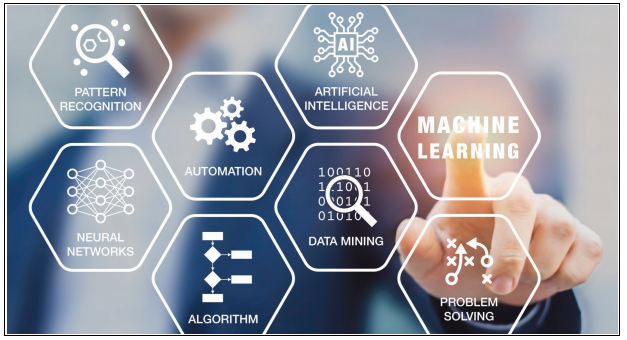As we enter the age of Siri and Alexa, the emergence of machine learning has a new
implication for the financial services industry. So how do we get it right?”
Machine learning (ML) in its most simplistic form is when a computer automatically learns, and uses that learning to predict the future course of action. The learnings could relate to data across all its forms across the universe of Big Data, to deduce further information, relate to insights and drive the course of action on that basis with predictions and decisions.
While ML and artificial intelligence (AI) find their applications across a variety of sectors ranging from healthcare to hospitality, the impact it has already made in the financial services sector can be particularly related to a few specific applications including fraud deductions, cyber security threat reduction, automated smartloan origination, preemptive collections, virtual assistance and algorithmic portfolio management. In addition to reducing the operational costs, ML environments allow for improved accuracy and a better customer experience.
There are 3 key areas that banks may need to explore as part of the digital value-chain, from the standpoint of this quick shift into the digital mainstream:
The estimated financial benefits in each use case have generally been positive. For instance, ML is estimated to drive down bad debt provision by more than 35%. Similar estimates also exist for each of the above applications. While there are multiple use cases that one gets to see every day, from chatbots to optical character recognition (OCR) and sentiment analysis, we will explore the effectiveness of ML in the context of fraud deduction, here. This is about building a correlation with a seemingly unrelated set of data, and helping to determine potentially fraudulent activity.
ML allows for identifying and preventing frauds, which otherwise may not have been deducted as a regular fraudulent activity. For example, a self-adaptive ML program would be able to connect the dots that link geo-location data with past transaction behaviour data to alert on potential fraudulent card transaction. A natural corollary to this is where geo-location details are used to increase customer intimacy and wallet share – an obvious example of this could be an instant discount offer to customers at outlets in the neighborhood where he/ she is located at that point in time.
The successful deployment of ML is a function of effective training of the system and accurate scoring – understanding the data, creation of models, generating insights and validation of output. This validation, confirming that there are no ‘false positives’ and training the system to detect such occurrences the next time, is an iterative process. This iteration, also called the Data Sciences Loop, is key to get the ML right. A case in point is where financial transactions are scanned for suspicious behaviour. While the effectiveness of the ML tool deployed is about predicting the fraudulent transactions accurately, it would be equally critical to minimise wrong deductions of legitimate transactions – which would result in excessive interference and customer dissatisfaction.
So how does one get the ML right, and what are the right components of an effective ML platform? We explore the three steps that are critical to getting ML to be truly effective.
Managing Big Data: getting the data model right
The current Covid-19 pandemic has created 3 distinct challenges for both banks, and their customers.
As ML platforms tend to be agnostic to data schema and the data sources tend to increase over a period of time, the ability to absorb new feeds of data becomes a key factor. Enterprise-level model development is taking centre stage, and the model outputs are now part of regulatory and business intelligence processes. A key challenge is where the data required by models sits outside the IT governance framework. Big Data management systems and data reservoirs have emerged to be the name of the game. Given that the data now made available spans across both human and machine generated in structured and unstructured forms – including social media, biometric, legacy and transactional data – having the right framework to clean, transform, store and enrich different types of data with a high-volume distributed file system is the first step for an effective ML. This, then, allows for driving a granular perspective of micro-segments, that allow for driving predictability. The key success factor here is the ability to drive an automated ingestion and accurate mapping of data from source systems into a central repository.
Continuous discovery: building effective ML models
As ML platforms tend to become more sophisticated, the model efficacy becomes a function of continuous improvement to the rules engine and the ML models. Determining misconduct in a trading activity, for example, is a continuous process of correlating discrete Natural Language Processing (NLP)-enabled data across telephonic calls and emails with the underlying trade. NLP allows for machines to decode human language, both written and spoken. Agile approaches allow for multiple rounds of testing to fine-tune results and improve the workflow, in what one would call as a continuous discovery process, and this forms the bedrock of any effective ML environment. The key here is to minimise external intervention, with a self-learning approach, using what is known to be the ‘Model Sandbox’. New ML models tend to offer a deeper and insightful view of the data, than what was previously possible.
Real-time execution: integrated architecture
The core value proposition of any ML tool is in the real-time processing and execution of the model. A case in point is when millions of crossborder transactions are processed for fraud detections, reducing the manual interventions in anti-money laundering validations. Determining that there is a potential fraud would be of no value, should the corrective action not be executed in real time. And this involves having an application architecture that is tightly integrated with the ML tools.
An extended example can be made about the use of ML in cyber security executing all the above three steps. Sifting reams of log-scans (data model) and determining hostile threats that need to be earlywarned (ML model) and executing an immediate act to self-protect the system from a data loss (real-time execution) are all carried out in real time for true impact. The concept of machine-to-machine exchange of information, driven by the Internet-of-Things (IoT) can also deliver its true potential only from an architecture that enables real-time execution.
While the examples discussed above are mostly built around financial fraud detection and innovation in regulatory solutions, the concept extends well across other domains, too. For instance, a well-developed ML platform could effectively conduct screening tests and background checks to validate if the applicant for a HR interview is indeed the person that he/she is claiming to be. Legal firms are looking to use ML to read and review contracts to identify risks embedded in them. With the emergence of machine readable regulations, we could expect to see a much lower error rate in interpretation that is presently resulting from ambiguity in understanding.
Are there areas to be extra sensitive here? Obviously, there is always another side to the coin. The sophistication of data analytics and ML also comes with the responsibility of more vigilant data security and governance. Investing in the right information architecture and improvising on it also becomes pertinent as sources of data evolve, and more importantly when machines have begun to learn how to get them effectively applied.
At the end of the day, the question still remains: can machines learn better than humans? The jury is still out there, but it would pay to watch some emerging examples – behavioural biometrics is one of them. Machines can now go well beyond signature verification, into recognising voice patterns, accents and even the distance to the mike based on the customer’s holding position of a phone. For sure, the days to come are likely to be more interesting than before.
To read more such insights from our leaders, subscribe to Cedar FinTech Monthly View


